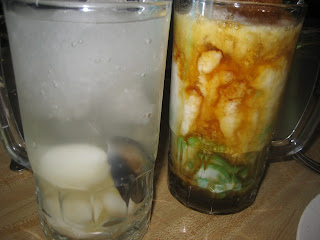We started with poh piah, spring rolls that are fresh, not fried. The ingredients are cooked but not the wheat-based skin in which they are rolled. These were filled with ground beef and veggies and served with a hot dipping sauce–if you zoom in on this photo, you’ll see enough red pepper seeds in there to set the entire neighborhood to crying. Whew! Poh piah is a major street food not only in Malaysia but throughout Southeast Asia. Note the platter: While most Malaysian meals I’ve had included at least one banana leaf used as a serving dish, the platter beneath the poh piah is actually made to LOOK like a giant banana leaf. At this restaurant I guess they opt for reusable dishes over the disposables. Of course, banana leaves are the ultimate in “green” dinnerware, so I guess this one’s a draw, huh?
The French have boeuf bourguignon, the Irish have beef and stout, and in Malaysia they have beef rendang. Instead of braising their beef in wine or stout, Malay cooks use coconut milk. The result is similar: a tough cut of beef that is cooked slowly on low heat until it is fall-apart tender. Only the flavorings are different, to reflect what is available locally. It was redolent with garlic, ginger, lemongrass, galangal, kaffir lime, star anise, cardamom, cinnamon and cloves. We ladled it over steamed rice, but it would have been just fine on its own. This stuff was heady and rich and wonderful.
I also fell in love with the claypot chicken curry. See all those chunks of mango in there? They added a rich sweetness to the chicken stew. It was wonderfully fragrant, with cumin and coriander, coconut milk and a hint of peanut. And some chiles, of course. Let’s not forget the heat! This dish fired on all cylinders. Yeah, I hid some steamed rice under this, too.
This char kuei teow, or fresh rice noodles, was served with tofu and greens. If it reminds you of chow mein, that’s the Chinese influence showing. Since we already had two chicken dishes and a beef dish, we opted for the tofu and vegetable version for the sake of variety. I admit, compared to the other dishes, this one seemed a little uninspired, but on the other hand, it provided a counterpoint to the more aggressively seasoned dishes. This one wasn’t made with eggs, but as with chow mein, it’s not uncommon to find them stirred in during the cooking.
Laksa is to Malaysians what chicken soup is to Americans–a bowl of warmth, nourishment and comfort. But laksa has much more complex flavors and ingredients that make it a richer and more satisfying meal. They simmer a broth base of coconut milk with an array of seasonings, then add in noodles, chicken and seafood. While this was a simpler version, I’ve had many bowls of laksa dressed with fresh raw ingredients on top, to stir in, for more flavor and varied textures.
While I had fruit juice with pineapple-stuffed rambutan in it, Himself got pandan cendol to drink–a party in a glass, I’d call it. This wildly colored drink was actually listed in the dessert category–and in fact is a particularly beloved dessert in Malaysia, but I don’t think he noticed that when he ordered it. It’s made of coconut milk–if you’re counting you’ll know that’s the fourth item on the table with coconut milk–with long noodles made from pandan leaves (that’s what looks like green worms in the bottom of the mug), and beans. Yes beans. Sweet, sweet beans, lovely, ruddy azuki beans in this case. The Asian cuisines know how to sweeten beans and use them in myriad ways we’ve never pondered in the West. But we should. They’re surely healthier than some things we snack on and indulge in.
We said “hold the shrimp” on all the dishes, since James is allergic, and we didn’t fancy hauling him into the emergency room. But in spite of this omission, each dish still held a bounty of flavor and texture.
From what I’m seeing in the news, tensions are rising between Malaysia and Indonesia, as each is accusing the other of stealing their culture. But let’s face it, they’re all interlaced, and their cuisines, like their cultures, are more alike than they are different. Looks to me like politics raising its ugly head, and that’s a shame. I’d much rather focus on the rich and diverse cultural aspects of this region–of any region.






















I love your blog and check it frequently. Keep up the wonderful writing. I'm reading!
Thanks, Susan!
Just let me know if you want to make one of these culinary adventures with us.
best,
Carol